 Website:
NETZSCH Grinding & Dispersing
Website:
NETZSCH Grinding & Dispersing
Group: NETZSCH
Catalog excerpts
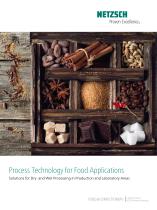
Process Technology for Food Applications Solutions for Dry- and Wet Processing in Production and Laboratory Areas FOOD & CONFECTIONERY a Business Field of NETZSCH Grinding & Dispersing
Open the catalog to page 1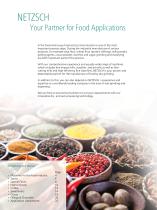
Your Partner for Food Applications In the food and luxury food sectors micronization is one of the most important process steps. During the industrial manufacture of various products, for example soya flour, wheat flour (protein shifting), milk powder, gelling agents, cocoa powder, starches and sugar, grinding and classifying are both important parts of the process. With our comprehensive experience and equally wide range of machines which includes fine impact mills, classifier- and jet mills as well as finecutting mills and high-efficiency fine classifiers, NETZSCH is your proven and dependable...
Open the catalog to page 2
Beater Blade Mill MASTERNIBS Confectionery System Fine Cutting Mills SECOMY® SECOMY® S Confectionery System High-Density Bed Jet Mill CONJET® Confectionery System Fine-Impact Mill CONDUX® ALPHA® Agitator Bead Mills MASTERREFINER Examples of Applications Flavors Baking additives Confectionery (cocoa press cakes, cocoa, …) Enzymes Colorings Fruit preparations, -powders Fillings / Compounds Spices Hydrocolloids (algae, pectin, gelatine, cellulose) Coffee Milk- & Dairy Products Chocolate Special Flours (protein shifting, soya flour, …) Sweeteners (sugar, artificial sweeteners, sugar substitutes)...
Open the catalog to page 3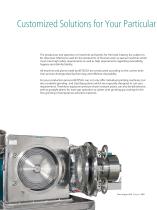
Customized Solutions for Your Particular The production and operation of machines and plants for the food industry are subject to EU-directives. Machines used for the production of food are seen as special machines which must meet high safety requirements as well as high requirements regarding cleanability, hygiene and disinfectability. All machine and plants made by NETZSCH are constructed according to the current directives and are distinguished by their easy and effective cleanability. For your production process NETZSCH can not only offer individual grinding machines, but also complete...
Open the catalog to page 4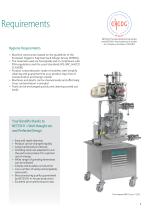
Requirements Hygiene Requirements NETZSCH Trockenmahltechnik GmbH and NETZSCH-Feinmahltechnik GmbH are company members of EHEDG Machine construction based on the guidelines of the European Hygienic Engineering & Design Group (EHEDG) The materials used are food grade and in compliance with FDA regulations and the usual standards (IFS, BRC, HACCP, IS 22000) Product-contacted parts made of stainless steel simplify cleaning and guarantee that your product stays free of contamination and foreign matter Machines and plants can be cleaned easily and effectively; Cross contamination is avoided...
Open the catalog to page 5
Gentle Grinding to Preserve the Characteristic Spices are dried plant parts, for example seeds, fruits, roots, bark, berries, peel, stems or leaves. These are used in nutritionally insignificant amounts as food additives for flavor and color or as preservatives. NETZSCH Flavor Protection Grinding When processing herbs and spices the highest priority is to preserve their characteristic properties as flavor-, aroma- or color carriers. Some spices already have their characteristic properties when they are freshlyharvested. In this case the natural flavors are completely enclosed by cell walls and...
Open the catalog to page 6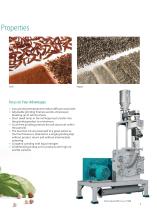
Focus on Your Advantages Low grinding temperatures reduce diffusion processes Adjustable grinding fineness avoids unnecessary breaking up of cell structures Short dwell times in the mill keep heat transfer into the grinding product to a minimum Crush-free grinding protects the cell structures within the particles The essential oils are preserved to a great extent as the final fineness is obtained in a single grinding step without product return and without intermediate screening Cryogenic grinding with liquid nitrogen Conditioned grinding air for products with high oiland fat contents
Open the catalog to page 7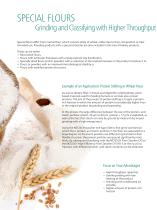
SPECIAL FLOURS Grinding and Classifying with Higher Throughput Special flours differ from normal flour, which consists solely of wheat, either due to their composition or their intended use. Powdery products with a special character are also included in the area of bakery products. These can be either Micronized flours, Flours with particular finenesses with a steep particle size distribution, Specially dried flours and/or powders with a reduction of the residual moisture in the product to below 5 %, Flours or powders with an improved microbiological stability or Flours with modified protein...
Open the catalog to page 8
8 Explosion protection valve 3 High-Performance Fine Classifier INLINESTAR Fine fraction with high protein content Coarse fraction with high amount of star
Open the catalog to page 9
Food Additives and Food Supplements with A large group of polysaccharides and proteins which have a high capacity for gelling are known as hydrocolloids. A large number of these originate from nature most of them from the plant world. However, hydrocolloids can also be obtained from algae, bacteria and animal sources. The extraction of hydrocolloids is carried out using several very different processes and often the products obtained are further modified in order to regulate certain properties. Hydrocolloids are used in the food industry as gelling- and thickening agents, stabilizers,...
Open the catalog to page 10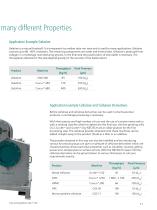
many different Properties Application Example Gelatine Gelatine is a natural foodstuff. It is transparent has neither odor nor taste and is used for many applications. Gelatine consists up to 80 - 90% of protein. The remaining components are water and mineral salts. Gelatine is produced from collagen in a multistage manufacturing process. In the final step the pulverization of extrudates is necessary. The throughputs obtained in this step depend greatly on the viscosity of the feed product. Final Fineness Application Example Cellulose and Cellulose Derivatives Before cellulose and cellulose...
Open the catalog to page 11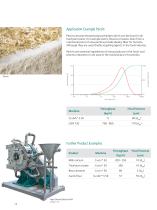
Application Example Pectin Pectins are plant-based polysaccharides which can be found in all hard plant parts, for example stems, flowers or leaves. Seen from a nutritional point of view pectins provide dietary fiber for humans, although they are used chiefly as gelling agents in the food industry. Pectins are essential ingredients of many products in the food- and pharma industries or are used in the manufacture of cosmetics. Cumulative Volume (%) Volume Density (%) Final Fineness Further Product Examples Throughput Final Fineness Tricalcium citrate Beta carotene Milk calcium Carob flour
Open the catalog to page 12All NETZSCH Grinding & Dispersing catalogs and technical brochures
-
NETZSCH MiniVac
2 Pages
-
NETZSCH ConduxVita
4 Pages
-
NETZSCH Pre-Grinding Mill ProPhi
12 Pages
-
NETZSCH Zumba
4 Pages
-
NETZSCH Image G&D
28 Pages
-
NETZSCH Connect
4 Pages
-
Pamir
4 Pages
-
Laboratory Mill MiniZeta
2 Pages
-
NETZSCH MasterCream
8 Pages
-
Salsa® System
12 Pages
-
NETZSCH-Beads®
20 Pages
-
NETZSCH Steam Jet Mill s-Jet®
20 Pages
-
NETZSCH Classifier Mills CSM
12 Pages
-
Milling of Spices
4 Pages
-
NETZSCH Fine Impact Mill CONDUX®
12 Pages
-
NETZSCH SPHERHO®
4 Pages
-
NETZSCH Fine Classifier CFS
8 Pages
-
EpsilonVita Inline Disperser
2 Pages
-
Vacuum De-Aerator DA/DA-VS
8 Pages
-
Inline Disperser MaxShear
4 Pages
-
PMD-VC Intensive Mixers
8 Pages
-
MasterMix® Dissolver
8 Pages
-
Ψ-Mix® Inline-Disperser
12 Pages
-
Discus Intensive Grinding System
12 Pages
-
NETZSCH Mill Control Systems
12 Pages
-
Atlas Vertical Roller Mill
4 Pages
-
URAL | Air classifier mill
4 Pages
-
Bora Air Classifier
4 Pages
-
Agitator Bead Mill Alpha®
24 Pages
-
MONSOON | Whizzer Classifier
4 Pages
-
Discus Grinding System
12 Pages
-
Nanomill Zeta RS
20 Pages
-
Zeta® Grinding System
8 Pages
-
Epsilon Inline Disperser
8 Pages
-
AfterSales Support
16 Pages
-
NETZSCH CaseStudy Tango
8 Pages
-
Discus Intensive Rotor
12 Pages
-
Grinding System Neos®
12 Pages
-
Netzsch filter and cyclones
12 Pages
-
NETZSCH SmartRemoval
4 Pages
-
NETZSCH Toll Grinding
8 Pages
-
Agitator Bead Mill DeltaVita®
12 Pages
-
NETZSCH_DeltaVitaMini
4 Pages
-
ALPHA®LAB
2 Pages
-
Fine Cutting Mill SecoMy
8 Pages
-
Laboratory Plants
20 Pages
-
NETZSCH Case Study Sakata
8 Pages
-
NETZSCH Case Study S&S
8 Pages























































































